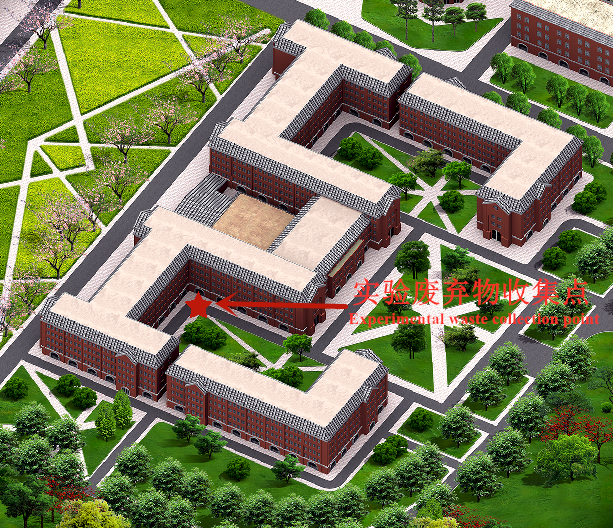In order to solve the problem of hidden safety hazards caused by the excessive storage of experimental waste in the laboratory, a new experimental waste transfer station has been built in the International Campus. The operating conditions are available. After discussion, it was decided to start the trial operation on November 9th. After the trial operation, the campus will arrange a transfer vehicle to transfer the experimental waste collected from the collection point to the transfer station. The details are notified as follows.
1. Experimental waste delivery and storage arrangements are as follows:
Types of waste collected | Collection time | Location | Person in charge | Remarks |
Inorganic acidic chemical waste, inorganic alkaline chemical waste, organic chemical waste, biochemical solid waste, reagent packaging | Mon, Wed, Fri 9:30am - 10:30am
| Corridors between 2C and 2B (see attached photo for details)
| Mr. Lu 13967330658 | No animal carcasses |
2. The requirements for delivery and storage of experimental waste are as follows:
i. In order to collect and handle experimental waste in an orderly and safe manner, please log on the official WeChat account of "Zhejiang University Laboratory and Equipment Management Department" before sending for storage. In the main page, search and register for "waste disposal" in order to record the disposal details. Staff/personnel in charge of collection point will collect the waste after checking that the waste sent for storage is correct according to the online declaration. All laboratories are requested to send for storage according to the specified classification requirements and collection time. If the storage of experimental waste are not delivered according to the regulations, the storage personnel will be asked to make corrections. Serious cases will be rejected.
ii. Each laboratory shall collect experimental waste separately and store them properly. A waste label should be affixed to the outside of the collection container, indicating the name of the waste and other information. Then, ensure that the container is tightly sealed, not broken or leaking.
iii. Chemical waste should be pretreated or recycled as much as possible. Measures should be taken to reduce the volume, weight and degree of harm of the chemical waste. In principle, the chemical liquid waste should be packed into the original bottle. If mixing is required, violent chemical reactions should be avoided.
iv. The experimental liquid waste should be collected and transported in special waste liquid containers (20L, 25L or 50L as required). The total volume of liquid waste must not exceed 80% of the liquid container. The outer cover must be covered to avoid liquid leakage during transportation.
v. Biochemical solid waste (excluding sharps) has to be packaged in dedicated yellow plastic bags. Biochemical solid waste contaminated with pathogenic microorganisms or waste contaminated with pathogenic microorganisms must be sterilized with high-pressure steam or be added and soaked into 2000mg/L of chlorine disinfectant for 1 hour to ensure inactivation and disinfection. Sharps should be properly packaged in strong and thick small cardboard boxes or other containers to avoid exposure and injury, and should be stored in dedicated yellow plastic bags.
vi. Radioactive waste is disposed by the waste-producing unit signing a recycling agreement with the relevant agency when purchasing it or in accordance with the plan approved by the environmental protection department.
vii. To collect waste labels and dedicated yellow plastic bags, please contact staff/personnel in charge of collection point. All waste producing units shall urge relevant laboratories to scientifically and reasonably collect, temporarily store and harmlessly treat experimental waste.
Attachment: Map of experimental waste collection point

Office of Campus Development and Management
Center for Academic Affairs
November 5, 2020
